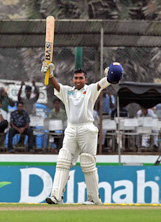COACHING
Bat and Pad
THE BAT
For a young lad, it is important to get a bat of the right size. It is a grave handicap for any youngster to learn the rudiments of the game with a bat of the wrong size.A full size bat is some 35 inches long, and a good serviceable bat weighs about 2 Ibs and 4 ounces. What is known as a 'short handle' bat has a blade of normal size but the handle is about one inch shorter.
Then we come to size "six" bats that are about 33 inches long, and sizes "five" and "four" that are correspondingly smaller.
As a guide, a boy whose height exceeds five feet, is big enough to use a full size bat of 35 inches.
There is no hard and fast rule that short men should use short handle bats and tall men should use long handle bats. The players themselves must decide which type suits them best. However, we do find more and more cricketers using short handle bats.

Besides the size and length of the handle, there
are grips of varying sizes; thin, medium and thick.
Here too, the player himself has to decide which
grip is most suitable for him. One must make sure
that the rubber grip on the handle is securely
glued. Many a wicket has been lost because the
rubber grip twists on the bat handle whilst making
a stroke. Worn-out rubber grips should be replaced
immediately.
Whilst choosing a bat, one must make sure that its grains as straight as possible. If the grains are close to each other, it means that the bat has 'power'. A bat having very few grains will last longer but it will not have the same power.
In choosing a bat, one must be guided by its feel and balance. It is very important how the bat feels in your hand.
Whilst choosing a bat, one must make sure that its grains as straight as possible. If the grains are close to each other, it means that the bat has 'power'. A bat having very few grains will last longer but it will not have the same power.
In choosing a bat, one must be guided by its feel and balance. It is very important how the bat feels in your hand.
LEG GUARDS
Leg-guards or Pads are worn on both legs to offer protection against injury. Whilst selecting leg- guards, one should see that they are not very heavy. Bulky, clumsy leg-guards will give more protection against injury, but they will to a certain extent restrict your footwork. One should select leg-guards that are comfortable and fit well.Leg-guards should be worn in such a way that the straps are on the outer side of the legs. They should not be kept hanging but properly buckled or strapped. If the leg-guards are worn in such a way that the straps are on the inner side, then they are likely to hinder the batsman whilst running between the wicket and the batsman may lose his balance and fall.
A top-grade cricketer should discard his pads and get new ones if the portion above the knee becomes flappy. Apart from the untidy appearance, there is the danger of being given out caught behind when the ball hits this loose portion and flies to the keeper, slips or short-leg. The sound of the ball hitting the flap can be mistaken as that of the ball finding the edge of the bat.
The leg-guards should be kept clean and one should ensure that the straps are intact before the start of a match.